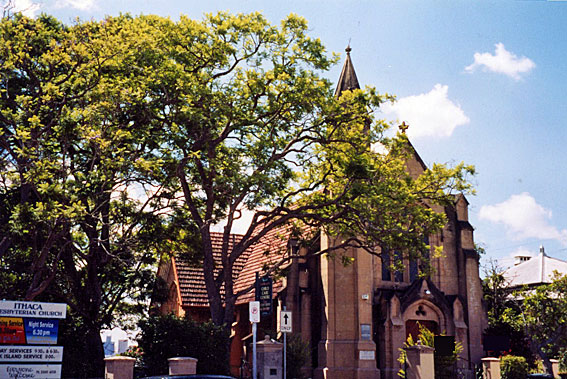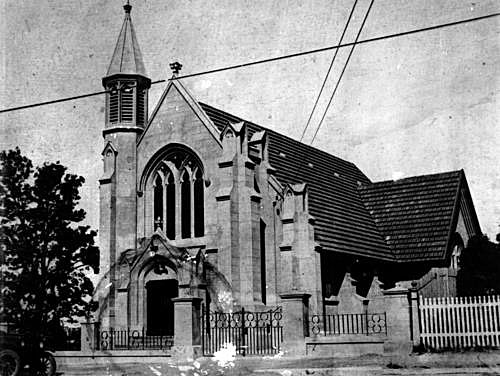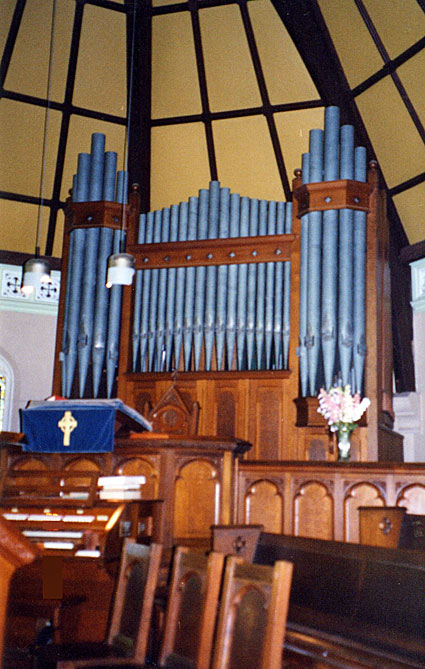
The Presbyterian Church, Ithaca
[Photograph by Geoffrey Cox (January 2004)]

The Presbyterian Church, Ithaca
[Photograph by Geoffrey Cox (January 2004)]
Historical and Technical Documentation by Geoffrey Cox
© OHTA 2012, 2016 (last updated November 2016)
The first Presbyterian service at Enoggera Terrace was held in 1880, and the first church was built (not on the present site) in 1885. The present church was built in 1928-29.1

The Presbyterian Church, Ithaca, c.1929
[Photograph: John Oxley Library, State Library of Queensland]
First Organ.
The first organ in this church was built by B.B.Whitehouse & Co. of Brisbane in 1905.2 It was not reported until February 1908 that the 'new organ had been paid for.'3 This instrument is now located at St Margaret's Anglican Girls' School, Ascot.
Present Organ.
The present organ was built in 1933 by Whitehouse Bros of Brisbane at a cost of £1,000. It was given as a memorial by the family of the late Mr F. T. Morris, and dedicated by the Rev. James Gibson on 19 November that year.4 A recital was given on the following Thursday, 23rd November:
The first recital on the F. T. Morris memorial organ was given by the organist and choirmaster (Mr. P. S. Templeton) at the Ithaca Presbyterian Church last night. Mr. Templeton touched on works by many of the great masters, and two [vocal] solos were given by Miss N. Shaw. Sterndale Bennett's "Barcarolle" was an especially popular number, and a free improvisation followed, demonstrating the tonal qualities of the stops in "Scotland's National Airs," and then a group of six short themes by composers, including Chopin, Schumann, Grieg, MacDowell, and Mendelssohn. The concluding number was "Offertoire in G," by Wely.5

The 1933 Whitehouse Bros organ
[Photograph by Geoffrey Cox (January 2004)]
This was one of several 'extension' instruments built by the Whitehouse firm around this time, others being at St Andrew's Presbyterian Church, Bundaberg (1932), Holy Rosary Catholic Church, Bundaberg (1933), St James' Catholic Church, Forest Lodge, NSW (1934), St Patrick's Catholic Cathedral, Toowoomba (1935) and the New England Girls' School, Armidale, NSW (1936). The Ithaca instrument was slightly more modest in size than some of the others.
The casework, comprising two towers with decorative braces and a central flat with transom rail, was standard to many Whitehouse organs of the late 1920s and early 1930s, including those at St Andrew's Presbyterian Church, Inverell (1927), St Paul's Presbyterian, Armidale (1929), St Andrew's Presbyterian, Chatswood (1930), St James' Catholic Church, Forest Lodge (1934), and St Patrick's Catholic Cathedral, Toowoomba (1935).
The console and most of the pipework were imported from Aug. Laukhuff of Germany, although the independent Pedal Bourdon 16ft stop was probably made in Brisbane.
The Whitehouse Bros firm was undoubtedly influenced in the building of these extension organs by their experience in maintaining two Wurlitzer theatre pipe organs that had been installed in Brisbane in the 1920s.6 The influence of the theatre organ was also evident in the use of Wurlitzer-type stop-tongues placed above the Swell manual of the Ithaca instrument.
A plaque on the console records that 'The Organ was enlarged in 1960 in memory of Douglas and Clark Loosemor,' and it can be assumed that this comprised the addition of two couplers (Swell to Great Sub Octave & Swell to Great Super Octave).7 Another plaque commemorates the 'restoration' of the organ to mark the centenary of the church (1885-1985).
In the original scheme, the specification comprised 3 extended ranks, with independent ranks for the Swell Oboe 8ft and Pedal Bourdon 16ft:
| GREAT Bourdon Open Diapason Stop Diapason Salicional Principal SWELL Bourdon Lieblich Gedact Viola Flute Violina Oboe PEDAL Bourdon Cello Flute COUPLERS Great to Pedal Swell to Pedal Swell to Great Swell to Great Sub Octave Swell to Great Super Octave |
16 8 8 8 4 16 8 8 4 4 8 16 8 4 |
A B A C B A A C A C C A |
[Ten. C] [Ten. C] [1960] [1960] |
Swell tremulant
Detached stop-key console
Electo-pneumatic action
Compass: 61/30
Balanced swell pedal
Pedalboard: radiating & concave.8
The organ was extensively rebuilt in 2000 by Ian D. Brown & Associates, the work involving the complete replacement of all the electrical parts other than the keyboards and some other console equipment, and the replacement of the pneumatic actions under the windchests with a form of direct electric action. The original five ranks were retained, but the extension system was completely reworked to provide an enlarged specification that is not reliant on sub and super couplers.9 New stop-keys were provided, with the following revised specification:
| GREAT Bourdon Open Diapason Stopped Diapason Salicional Principal Twelfth Fifteenth Oboe SWELL Open Diapason Stopped Diapason Salicional Stopped Flute Salicet Piccolo Quint Contra Oboe Oboe PEDAL Bourdon Principal Bass Flute Quint Fifteenth Contra Oboe Oboe COUPLERS Great to Pedal Swell to Pedal Swell to Great |
16 8 8 8 4 2-2/3 2 8 8 8 8 4 4 2 1-1/3 16 8 16 8 4 5-1/3 4 16 8 |
A B A C B C+A B+A D B A C A C A C+A D D A B A A B D D |
[unenclosed] [Ten. C] + independent [resultant bass] |
Swell tremulant
Detached stop-key console
Direct electric action
Compass: 61/30
Balanced swell pedal
Pedalboard: radiating & concave.10
___________________________________________________________________
1 Richard Bardon, The Centenary History of The Presbyterian Church of Queensland (Brisbane: W. R. Smith & Paterson, 1949), p. 235.
2 The Brisbane Courier (25 November 1905), p. 16.
3 The Brisbane Courier (19 February 1908), p. 4.
4 Date and cost from Whitehouse Bros Ledger (1922-1940), p. 478. Dedication details from plaque on the organ (cited 1974), and from The Courier-Mail (18 November 1933), p. 5 & (20 November 1933), p. 4.
5 The Courier-Mail (24 November 1933), p. 17.
6 These were at the Wintergarden Theatre and the Regent Theatre.
7 These two couplers were not present when Bernie Brohan recorded the specification in the early 1950s, although they were present in 1974 (see below). Details of additions confirmed by Kevin Whitehouse, 1974.
8 Specification noted by G. Cox, 1974.
9 The Sydney Organ Journal, vol. 31, no. 4 (Spring 2000), p. 26 & The Organ Voice, vol. 26, no. 3 (Sept. 2000), p. 25.
10 Specification noted by G. Cox, January 2004.